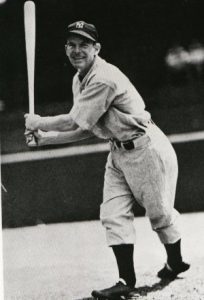With five World Series rings, he’s Canada’s Mr. October.
Unfortunately, the vast majority of baseball fans don’t know who he is.
“Not even hardcore Yankees fans are going to remember George Selkirk,” said Richard Tofel, author of A Legend in the Making: The New York Yankees in 1939.
Born in Huntsville, Ont., Selkirk had the misfortune of replacing Babe Ruth in right field for the Bronx Bombers. The upstart Canadian not only assumed The Bambino’s position in 1935, but he also donned No. 3.
“I was just cocky enough to say, ‘Wearing Babe’s number won’t make me nervous. If I’m going to take his place, I’ll take his number too,'” explained Selkirk in a 1936 interview, reported in Jim Shearon’s book, Canada’s Baseball Legends.
Later in his career, however, Selkirk wasn’t as enthusiastic about his decision.
“I got his (Ruth’s) job and it took a long time for people to forgive me,” he lamented, in an interview reported in Tofel’s book.
“I think the reception Selkirk got from fans was lukewarm at best,” explained Tofel. “I think he was booed and resented. The Babe was the most popular player, really, in many ways, in the history of baseball.”
But Selkirk would overcome the jeers to enjoy a productive big league career. Suiting up alongside immortals like Lou Gehrig, Joe DiMaggio, Bill Dickey and Lefty Gomez, the talented Canadian hit over .300 five times in nine seasons. He was also a key contributor to the Yankees’ four consecutive World Series titles from 1936 to 1939.
In a recent release, the Canadian Baseball Hall of Fame indicated that Selkirk has toiled in more World Series games (21) than any other Canuck. He also tops Canadians in World Series hits (18), RBIs (10), walks (11) and, most importantly, championship rings (5).
The Huntsville native made a splash in his Fall Classic debut on September 30, 1936, when he hammered a screw ball from Hall of Famer Carl Hubbell over the right field wall at the Polo Grounds in his first World Series at bat. He’s one of just 34 major leaguers – and the only Canadian – to homer in his inaugural Fall Classic at bat.
But statistics and accomplishments aside, who is Canada’s Mr. October?
Selkirk was born in Huntsville in 1908 and moved to Rochester, N.Y., when he was five. Shearon’s book reveals that the Canadian was a star catcher on his high school team when he first attracted the attention of scouts. Dubbed Twinkletoes for his distinct running style, Selkirk’s professional baseball odyssey began in 1927.
After seven seasons in the minors, including a stop with the International League’s Toronto Maple Leafs in 1932, he would make his big league debut on August 12, 1934. Supplanting The Bambino in the Yanks’ outfield the following year, Selkirk hit .312 and knocked in 94 runs.
In 1937, the underrated Canuck was hitting .344 and was tied for the league lead in home runs when he broke his collarbone diving for a fly ball on Canada Day. His finest season was in 1939 when he knocked in 101 runs, recorded a team-high 103 walks and finished with a .452 on-base percentage. He was also on the field for Lou Gehrig’s emotional retirement speech.
Little has been written about Selkirk’s personality. However, a story from longtime Yankee Tommy Henrich’s biography illustrating Selkirk’s playful side is included in Tofel’s book.
“After he (Selkirk) joined the Yankees, he once hit a screaming drive to center, an easy double by the look of it. When the center fielder instead made a leaping catch, Selkirk not yet at first, ‘jumped into the air, whirled and ran back down the first-base line and slid into home plate,'” writes Tofel.
Selkirk’s strength was also legendary in the Yankees clubhouse. Tofel uncovered that the steady Canadian outfielder was “the only man who could wrestle a healthy Gehrig to a draw.”
And judging by his post-playing career, Selkirk was also a student of the game. He served as a minor league manager in the Yankees and Milwaukee Braves organizations, and would later work in player development roles with the Kansas City Athletics and Baltimore Orioles. In 1964, he was named general manager of the Washington Senators, a post he would hold until 1969, before returning to the Yankees as a scout. For his accomplishments as a player and executive, Selkirk was inducted into the Canadian Baseball Hall of Fame in 1983.
The man they called Twinkletoes died in Pompano Beach, Fla., in 1987, but his legacy lives on, especially amongst dedicated Canadian baseball enthusiasts.
“He didn’t get the full appreciation that he might have because the Yankees had all of those other great players,” said renowned Canadian baseball statistician Neil Munro.













